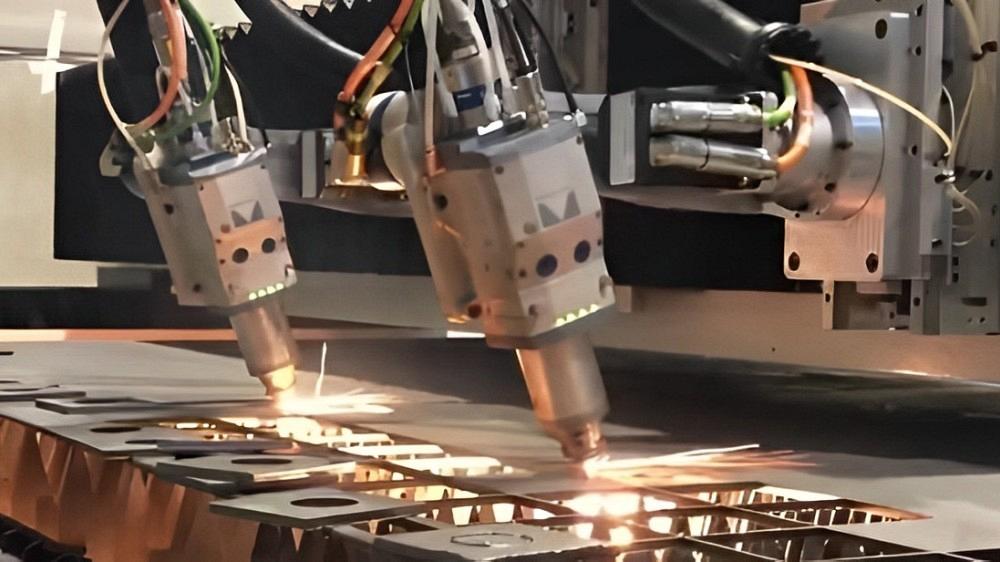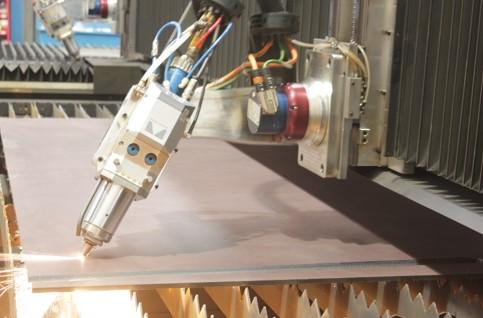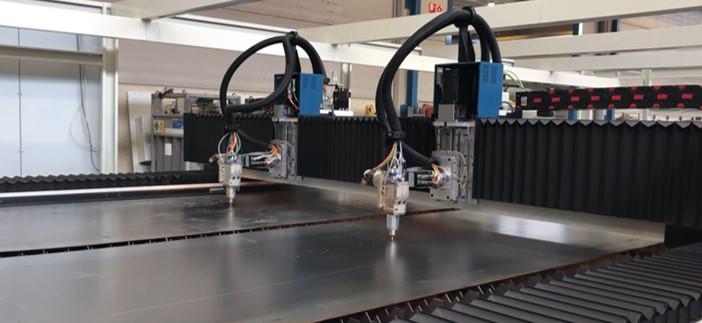Export Manager
- FMA
- The Fabricator
- FABTECH
- Canadian Metalworking
Categories
- Additive Manufacturing
- Aluminum Welding
- Arc Welding
- Assembly and Joining
- Automation and Robotics
- Bending and Forming
- Consumables
- Cutting and Weld Prep
- Electric Vehicles
- En Español
- Finishing
- Hydroforming
- Laser Cutting
- Laser Welding
- Machining
- Manufacturing Software
- Materials Handling
- Metals/Materials
- Oxyfuel Cutting
- Plasma Cutting
- Power Tools
- Punching and Other Holemaking
- Roll Forming
- Safety
- Sawing
- Shearing
- Shop Management
- Testing and Measuring
- Tube and Pipe Fabrication
- Tube and Pipe Production
- Waterjet Cutting
Industry Directory
Webcasts
Podcasts
FAB 40
Advertise
Subscribe
Account Login
Search
Are two heads better than one in fiber laser cutting?
Enhancing quality and efficiency with a second cutting head
- By Antonio Calero
- April 22, 2024
- Article
- Laser Cutting

Two cutting heads on a laser cutting machine allow for increased material throughput. Jordi Tech & Innovation
With its unmatched accuracy and speed, fiber laser technology has transformed metal cutting processes. And in this case, as the saying goes, two heads can be better than one.
Using two laser heads enables simultaneous cutting on a single sheet or two separate sheets, and each head can be operated independently or in tandem to handle various cutting requirements. With two cutting heads, fabricators are effectively using the full width of the machine. This setup allows for increased material throughput, accommodating larger or more complex projects with shorter lead times.
Dual-Head Cutting Advantages
In addition to its effect on material throughput, dual-head cutting can offer other benefits to fabricating shops.
Cut Quality. When two laser cutting heads are precisely coordinated to work in tandem, they can deliver perfectly aligned cuts to produce consistent manufactured components that require no further finishing operations.
For instance, in bevel cutting of thick steel plates—an essential step before welding in such industries as shipbuilding, construction equipment, wind power, and pipe fabrication—dual heads that both offer bevel cutting features can create homogeneous welds with good penetration and reduced heat-related distortion.
Operating Costs. While the acquisition of a double-head gantry fiber laser cutting machine requires a capital investment, it shouldn’t impact operating costs going forward. Fiber laser cutting is inherently energy efficient, so the addition of a second head won’t increase the cost of consumables, production, or energy.
Productivity. Using a second cutting head that performs multiple cuts at once doubles production output. This is particularly helpful for manufacturing high-volume parts for such sectors as automotive, aerospace, and construction.
System Design and Control
While a dual-head setup can have many advantages, achieving optimal cutting results requires careful consideration of several factors. One critical aspect is the control of accelerations during the cutting process. Inadequate control can result in poor cut quality, excess burr formation, and molten material accumulation.
To address this challenge, advanced control systems are used to manage the speed and direction of the cutting heads. This helps ensure efficient material removal while minimizing thermal effects and producing clean, high-quality cuts, particularly at corners and on intricate contours.
Furthermore, the mechanical design and construction of the laser cutting equipment play crucial roles in achieving precise cutting with dual heads. High-precision machining, robust rack-and-guide systems, and meticulous assembly are essential to maintain accurate positioning and cutting speeds, especially when configuring a dual-head cutting system.

Bevel cutting on a laser cutting machine is especially important when shops are making parts for industries such as shipbuilding and construction.
The combination of an advanced control system and robust mechanical design can enable a dual-head system to process complex geometries efficiently, increasing throughput and helping to enhance profitability in the manufacturing process.
A Promising Choice
A fiber laser cutting machine equipped with a second cutting head can help increase productivity and quality while reducing operating costs.
For metal fabricators evaluating their equipment purchase options, dual-head fiber laser cutting is a promising choice that could help them achieve a competitive advantage.
About the Author
Related Companies
subscribe now

The Fabricator is North America's leading magazine for the metal forming and fabricating industry. The magazine delivers the news, technical articles, and case histories that enable fabricators to do their jobs more efficiently. The Fabricator has served the industry since 1970.
start your free subscription- Stay connected from anywhere

Easily access valuable industry resources now with full access to the digital edition of The Fabricator.

Easily access valuable industry resources now with full access to the digital edition of The Welder.

Easily access valuable industry resources now with full access to the digital edition of The Tube and Pipe Journal.
- Podcasting
- Podcast:
- The Fabricator Podcast
- Published:
- 04/30/2024
- Running Time:
- 53:00
Seth Feldman of Iowa-based Wertzbaugher Services joins The Fabricator Podcast to offer his take as a Gen Zer...
- Industry Events
Pipe and Tube Conference
- May 21 - 22, 2024
- Omaha, NE
World-Class Roll Forming Workshop
- June 5 - 6, 2024
- Louisville, KY
Advanced Laser Application Workshop
- June 25 - 27, 2024
- Novi, MI
Precision Press Brake Certificate Course
- July 31 - August 1, 2024
- Elgin,
































